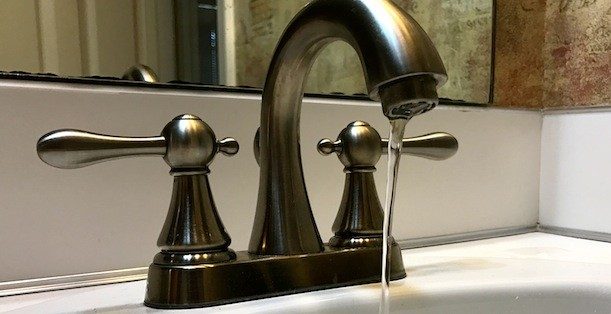Water revenue loss could be up to $2.5 million a year, according to Fort Smith utility boss
by April 24, 2018 8:21 pm 1,496 views

Fort Smith Utilities Director Jerry Walters on Tuesday (April 24) updated the Board on several projects his department has going, including how the city could be losing between $2 million and $2.5 million in revenue annually based on excessive water loss.
His update also included the $118 million 48-inch transmission line project from the Lake Fort Smith water treatment plant, and ongoing water meter replacements. The largest item on the agenda was the Lake Fort Smith project. The treatment facility was originally constructed in 1936 and upgraded in 1963. Last major renovations and upgrades were in 2012.
The city has spent $17.086 million to complete the first phase (6 miles) of the $118.939 million transmission line project from Mountainburg to Grotto, as well as part of the design for phase two. Phase two — Grotto to Interstate 40 — is scheduled for completion by January 2019 at a cost of $35.313 million. It will be 12 miles altogether.
There are no clear timelines on when the other four phases will start or finish. Phase three (the Lee Creek interconnect, $6.67 million) is on hold as the department reviews requirements. That will be followed by a 14.77-mile stretch (the “Arkansas River Valley” stretch, $42.09 million), Arkansas River crossing at I-49 (4.1 miles, $8.05 million), and another Arkansas River crossing interconnect at Van Buren (0.44 miles, $12.075 million). Once completed, the 48-inch transmission line will be able to provide a maximum of 48 million gallons per day (MGD, currently 40 MGD), and it will carry approximately 67% of the water from the Lake Fort Smith plant.
The plant is now served by a 36-inch line (65% of transmission) and a 27-inch line (35%). For the funding of a project this large, Walters said “bonding it out” would be a viable option. Also, “There are a couple of programs run by the federal government and through the state government that provide funding for big projects.”
“You still have to pay it back, but it’s really low interest, and they’re pretty generous on repayment terms,” Walters told Talk Business & Politics. Through one program, Walters said, “You don’t have to pay until you draw the money out,” and on another, “you don’t have to pay until five years after the project is complete.”
The department also is working to establish a sinking fund for the first time in its history to help pay for “million-dollar projects,” but with a project the size of the 48-inch, “it would take too long to save up that amount of money,” Walters said.
In addition to the Lake Fort Smith plant, which accounted for 72% of usable water in 2017, the city operates a second treatment plant at Lee Creek (28% of production in 2017). It also maintains 720 miles of water lines in the service region as well as 11 pressure-reducing stations and 21 pump stations to move water throughout the area. Beyond Fort Smith, the department provides water services to 14 locations in Arkansas – Van Buren and Barling being the two largest – and two locations in eastern Oklahoma (Arkoma and Rural Water District No. 7). As of March 31, 2018, there were 37,092 metered accounts and a total estimated population of 148,000.
On a related note, the city built The Woods water tower and pump station to provide service to areas of eastern Fort Smith (Chaffee Crossing) in higher elevations — areas that now include ArcBest’s headquarters and the Providence subdivision. The Chaffee Crossing reservoir was brought online in 2017 to help areas south of Massard Road (namely, the Stoneshire subdivision).
Based on the network configuration and pump stations, Chaffee Crossing has a maximum water supply of 3,370 gallons per minute (GPM). Current upgrades have been designed and built in anticipation of the future 48-inch Lake Fort Smith water transmission line project to better serve the area, which, as Director Tracy Pennartz pointed out Tuesday, is “where most of the growth is going to occur in Fort Smith.” Chaffee’s usage has spiked considerably since 2003 when it was just 750 GPM. Current use is around 2,500 GPM.
METER REPLACEMENTS, WATER LOSSES
A second piece of Walters’ report touched on meter replacements and the issue of water loss that could be costing the city a minimum of $2 million in revenue annually. Walters told Talk Business & Politics the potential revenue impact was “probably between $2-$2.5 million.”
“Most of it is coming from water line leaks, which is probably the biggest one, and we think the meters are under-reading, and that’s why we’re doing a major project to replace them. We think that between those two, that will bring it back down to where we should be. The meters are old in most cases, and they wear out. They haven’t been replaced for 30-or-so years,” Walters said.
Walters said water system losses, or the amount of water produced versus the amount metered, should generally be around 10%, but the city is losing more than 20%. For each 5% loss, the city loses a retail revenue value of approximately $1 million.
In October, the city announced it would begin replacing outdated meters at an overall project cost of $7 million. At the time, the city said it had 36,589 meters. From these, roughly 16,800 had exceeded their normal life expectancy (45.91%) with 9,500 of those (25.96% of the total) at more than 20 years old. The city anticipated rates for the 9,500 could see an average increase of 21.3% on their water bills. The additional 7,300 that have outlived the recommended 10 years (19.95% of the city’s total metered population) would likely see smaller increases, but nothing will be known for certain until the meters are replaced and the department has a chance to review the new data.
